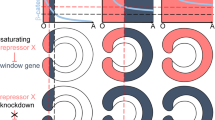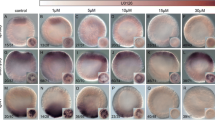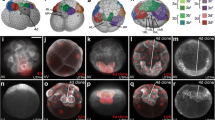Abstract
The fibroblast growth factor (FGF) signal transduction pathway serves as one of the key regulators of early metazoan development, displaying conserved roles in the specification of endodermal, mesodermal, and neural fates during vertebrate development. FGF signals also regulate gastrulation, in part, by triggering epithelial to mesenchymal transitions in embryos of both vertebrates and invertebrates. Thus, FGF signals coordinate gastrulation movements across many different phyla. To help understand the breadth of FGF signaling deployment across the animal kingdom, we have examined the presence and expression of genes encoding FGF pathway components in the anthozoan cnidarian Nematostella vectensis. We isolated three FGF ligands (NvFGF8A, NvFGF8B, and NvFGF1A), two FGF receptors (NvFGFRa and NvFGFRb), and two orthologs of vertebrate FGF responsive genes, Sprouty (NvSprouty), an inhibitor of FGF signaling, and Churchill (NvChurchill), a Zn finger transcription factor. We found these FGF ligands, receptors, and response gene expressed asymmetrically along the oral/aboral axis during gastrulation and in a developing chemosensory structure of planula stages known as the apical tuft. These results suggest a conserved role for FGF signaling molecules in coordinating both gastrulation and neural induction that predates the Cambrian explosion and the origins of the Bilateria.







Similar content being viewed by others
References
Abascal F, Zardoya R, Posada D (2005) ProtTest: selection of best-fit models of protein evolution. Bioinformatics 21:2104–2105
Amaya E, Stein PA, Musci TJ, Kirschner MW (1993) FGF signalling in the early specification of mesoderm in Xenopus. Development 118:477–487
Bertrand V, Hudson C, Caillol D, Popovici C, Lemaire P (2003) Neural tissue in ascidian embryos is induced by FGF9/16/20, acting via a combination of maternal GATA and Ets transcription factors. Cell 115:615–627
Branda CS, Stern MJ (2000) Mechanisms controlling sex myoblast migration in Caenorhabditis elegans hermaphrodites. Dev Biol 226:137–151
Bulow HE, Boulin T, Hobert O (2004) Differential functions of the C. elegans FGF receptor in axon outgrowth and maintenance of axon position. Neuron 42:367–374
Cebria F, Kobayashi C, Umesono Y, Nakazawa M, Mineta K, Ikeo K, Gojobori T, Itoh M, Taira M, Sanchez Alvarado A, Agata K (2002) FGFR-related gene nou-darake restricts brain tissues to the head region of planarians. Nature 419:620–624
Ciruna B, Rossant J (2001) FGF signaling regulates mesoderm cell fate specification and morphogenetic movement at the primitive streak. Dev Cell 1:37–49
Collins AG, Cartwright P, McFadden CS, Scheirwater B (2005) Phylogenetic context and basal metazoan model systems. Integr Comp Biol 45:585–594
Darras S, Nishida H (2001) The BMP signaling pathway is required together with the FGF pathway for notochord induction in the ascidian embryo. Development 128:2629–2638
De Robertis EM, Kuroda H (2004) Dorsal-ventral patterning and neural induction in Xenopus embryos. Annu Rev Cell Dev Biol 20:285–308
Delaune E, Lemaire P, Kodjabachian L (2005) Neural induction in Xenopus requires early FGF signalling in addition to BMP inhibition. Development 132:299–310
Eswarakumar VP, Lax I, Schlessinger J (2005) Cellular signaling by fibroblast growth factor receptors. Cytokine Growth Factor Rev 16:139–149
Forni JJ, Romani S, Doherty P, Tear G (2004) Neuroglian and FasciclinII can promote neurite outgrowth via the FGF receptor Heartless. Mol Cell Neurosci 26:282–291
Fritzenwanker JH, Saina M, Technau U (2004) Analysis of forkhead and snail expression reveals epithelial–mesenchymal transitions during embryonic and larval development of Nematostella vectensis. Dev Biol 275:389–402
Garcia-Alonso L, Romani S, Jimenez F (2000) The EGF and FGF receptors mediate neuroglian function to control growth cone decisions during sensory axon guidance in Drosophila. Neuron 28:741–752
Gerhart J (1999) 1998 Warkany lecture: signaling pathways in development. Teratology 60:226–239
Griffin K, Patient R, Holder N (1995) Analysis of FGF function in normal and no tail zebrafish embryos reveals separate mechanisms for formation of the trunk and the tail. Development 121:2983–2994
Guindon S, Gascuel O (2003) A simple, fast, and accurate algorithm to estimate large phylogenies by maximum likelihood. Syst Biol 52:696–704
Hacohen N, Kramer S, Sutherland D, Hiromi Y, Krasnow MA (1998) sprouty encodes a novel antagonist of FGF signaling that patterns apical branching of the Drosophila airways. Cell 92:253–263
Huang P, Stern MJ (2005) FGF signaling in flies and worms: more and more relevant to vertebrate biology. Cytokine Growth Factor Rev 16:151–158
Imai KS, Satoh N, Satou Y (2002) Early embryonic expression of FGF4/6/9 gene and its role in the induction of mesenchyme and notochord in Ciona savignyi embryos. Development 129:1729–1738
Imai KS, Satoh N, Satou Y (2003) A twist-like bHLH gene is a downstream factor of an endogenous FGF and determines mesenchymal fate in the ascidian embryos. Development 130:4461–4472
Isaacs HV, Pownall ME, Slack JM (1994) eFGF regulates Xbra expression during Xenopus gastrulation. EMBO J 13:4469–4481
Itoh N, Ornitz DM (2004) Evolution of the Fgf and Fgfr gene families. Trends Genet 20:563–569
Kim HJ, Bar-Sagi D (2004) Modulation of signalling by Sprouty: a developing story. Nat Rev Mol Cell Biol 5:441–450
King N, Carroll SB (2001) A receptor tyrosine kinase from choanoflagellates: molecular insights into early animal evolution. Proc Natl Acad Sci USA 98:15032–15037
King N, Hittinger CT, Carroll SB (2003) Evolution of key cell signaling and adhesion protein families predates animal origins. Science 301:361–363
Klambt C, Glazer L, Shilo BZ (1992) Breathless, a Drosophila FGF receptor homolog, is essential for migration of tracheal and specific midline glial cells. Genes Dev 6:1668–1678
Koshida S, Shinya M, Nikaido M, Ueno N, Schulte-Merker S, Kuroiwa A, Takeda H (2002) Inhibition of BMP activity by the FGF signal promotes posterior neural development in zebrafish. Dev Biol 244:9–20
Kraus Y, Technau U (2006) Gastrulation in the sea anemone Nematostella vectensis occurs by invagination and immigration: an ultrastructural study. Dev Genes Evol 216:119–132
Kusserow A, Pang K, Sturm C, Hrouda M, Lentfer J, Schmidt HA, Technau U, von Haeseler A, Hobmayer B, Martindale MQ, Holstein TW (2005) Unexpected complexity of the Wnt gene family in a sea anemone. Nature 433:156–160
Martin GR (1998) The roles of FGFs in the early development of vertebrate limbs. Genes Dev 12:1571–1586
Martindale MQ, Pang K, Finnerty JR (2004) Investigating the origins of triploblasty: ‘mesodermal’ gene expression in a diploblastic animal, the sea anemone Nematostella vectensis (phylum, Cnidaria; class, Anthozoa). Development 131:2463–2474
Matus DQ, Pang K, Marlow H, Dunn CW, Thomsen GH, Martindale MQ (2006a) Molecular evidence for deep evolutionary roots of bilaterality in animal development. Proc Natl Acad Sci USA 103:11195–11200
Matus DQ, Thomsen GH, Martindale MQ (2006b) Dorso/ventral genes are asymmetrically expressed and involved in germ-layer demarcation during cnidarian gastrulation. Curr Biol 16:499–505
Miller DJ, Ball EE, Technau U (2005) Cnidarians and ancestral genetic complexity in the animal kingdom. Trends Genet 21:536–539
Min H, Danilenko DM, Scully SA, Bolon B, Ring BD, Tarpley JE, DeRose M, Simonet WS (1998) Fgf-10 is required for both limb and lung development and exhibits striking functional similarity to Drosophila branchless. Genes Dev 12:3156–3161
Mineta K, Nakazawa M, Cebria F, Ikeo K, Agata K, Gojobori T (2003) Origin and evolutionary process of the CNS elucidated by comparative genomics analysis of planarian ESTs. Proc Natl Acad Sci USA 100:7666–7671
Miya T, Nishida H (2003) An Ets transcription factor, HrEts, is target of FGF signaling and involved in induction of notochord, mesenchyme, and brain in ascidian embryos. Dev Biol 261:25–38
Nielsen C (2005) Larval and adult brains. Evol Dev 7:483–489
Nutt SL, Dingwell KS, Holt CE, Amaya E (2001) Xenopus Sprouty2 inhibits FGF-mediated gastrulation movements but does not affect mesoderm induction and patterning. Genes Dev 15:1152–1166
Ornitz DM, Itoh N (2001) Fibroblast growth factors. Genome Biol 2(3):REVIEWS3005
Pang K, Matus DQ, Martindale MQ (2004) The ancestral role of COE genes may have been in chemoreception: evidence from the development of the sea anemone, Nematostella vectensis (phylum Cnidaria; class Anthozoa). Dev Genes Evol 214:134–138
Popovici C, Roubin R, Coulier F, Birnbaum D (2005) An evolutionary history of the FGF superfamily. Bioessays 27:849–857
Powers CJ, McLeskey SW, Wellstein A (2000) Fibroblast growth factors, their receptors and signaling. Endocr Relat Cancer 7:165–197
Ronquist F, Huelsenbeck JP (2003) MrBayes 3: Bayesian phylogenetic inference under mixed models. Bioinformatics 19:1572–1574
Rossant J, Ciruna B, Partanen J (1997) FGF signaling in mouse gastrulation and anteroposterior patterning. Cold Spring Harbor Symp Quant Biol 62:127–133
Satou Y, Imai KS, Satoh N (2002) Fgf genes in the basal chordate Ciona intestinalis. Dev Genes Evol 212:432–438
Schulte-Merker S, Smith JC (1995) Mesoderm formation in response to Brachyury requires FGF signalling. Curr Biol 5:62–67
Sheng G, dos Reis M, Stern CD (2003) Churchill, a zinc finger transcriptional activator, regulates the transition between gastrulation and neurulation. Cell 115:603–613
Shishido E, Ono N, Kojima T, Saigo K (1997) Requirements of DFR1/Heartless, a mesoderm-specific Drosophila FGF-receptor, for the formation of heart, visceral and somatic muscles, and ensheathing of longitudinal axon tracts in CNS. Development 124:2119–2128
Sivak JM, Petersen LF, Amaya E (2005) FGF signal interpretation is directed by Sprouty and Spred proteins during mesoderm formation. Dev Cell 8:689–701
Stathopoulos A, Tam B, Ronshaugen M, Frasch M, Levine M (2004) Pyramus and thisbe: FGF genes that pattern the mesoderm of Drosophila embryos. Genes Dev 18:687–699
Sudhop S, Coulier F, Bieller A, Vogt A, Hotz T, Hassel M (2004) Signalling by the FGFR-like tyrosine kinase, Kringelchen, is essential for bud detachment in Hydra vulgaris. Development 131:4001–4011
Sullivan JC, Ryan JF, Watson JA, Webb J, Mullikin JC, Rokhsar D, Finnerty JR (2006) StellaBase: the Nematostella vectensis genomics database. Nucleic Acids Res 34:D495–D499
Sutherland D, Samakovlis C, Krasnow MA (1996) Branchless encodes a Drosophila FGF homolog that controls tracheal cell migration and the pattern of branching. Cell 87:1091–1101
Swofford DL (1998) PAUP*: phylogenetic analysis using parsimony (*and other methods). Sinauer Associates, Sunderland, MA
Technau U (2001) Brachyury, the blastopore and the evolution of the mesoderm. Bioessays 23:788–794
Technau U, Scholz CB (2003) Origin and evolution of endoderm and mesoderm. Int J Dev Biol 47:531–539
Technau U, Rudd S, Maxwell P, Gordon PM, Saina M, Grasso LC, Hayward DC, Sensen CW, Saint R, Holstein TW, Ball EE, Miller DJ (2005) Maintenance of ancestral complexity and non-metazoan genes in two basal cnidarians. Trends Genet 21:633–639
Wallberg A, Thollesson M, Farris JS, Jondelius U (2004) The phylogenetic position of the comb jellies (Ctenophora) and the importance of taxonomic sampling. Cladistics 20:558–578
Yang X, Dormann D, Munsterberg AE, Weijer CJ (2002) Cell movement patterns during gastrulation in the chick are controlled by positive and negative chemotaxis mediated by FGF4 and FGF8. Dev Cell 3:425–437
Zhang X, Stappenbeck TS, White AC, Lavine KJ, Gordon JI, Ornitz DM (2006) Reciprocal epithelial–mesenchymal FGF signaling is required for cecal development. Development 133:173–180
Author information
Authors and Affiliations
Corresponding author
Additional information
Communicated by D. A. Weisblat
Electronic supplementary material
Below is the link to the electronic supplementary material.
S1
A Bayesian phylogenetic analysis of FGF ligands. Previous studies have identified eight classes of FGFs within the Metazoa (Popovici et al. 2005). We identified 13 putative genes that possessed FGF core domains within the N. vectensis genome (Joint Genome Institute). Of the 13, a Bayesian analysis confirms the orthology for four FGF ligands (blue arrows) all within the FGF-D class (FGF8/17/18). The remaining nine ligands (black arrows) in the N. vectensis genome appear to cluster together and may either represent cnidarian-specific FGF groups or belong to one of the established classes, but the phylogenetic relationship has been obscured. N. vectensis sequences are shown in bold with arrows. Boxes demark those FGF ligands, where expression patterns have been determined. Numbers above branches indicate posterior probabilities (GIF 20 kb)
S2
A Bayesian phylogenetic analysis of FGFRs. N. vectensis possesses 3 putative RTKs that by BLASTX searches were classified as FGFRs. A Bayesian phylogenetic analysis confirms that two of the three are legitimate FGFRs. NvFGFRa and NvFGFRb are most closely related to an FGFR from a hydrozoan cnidarian, Hydra FGFR-like (kringelchen) and the lone FGFR in the C. elegans genome, egl-15. The third receptor, NvFGFRc, groups with a hydrozoan RTK of a different family (P. carnea VEGFR) and is likely not a true FGFR. N. vectensis FGFRs are indicated by boxes and arrows. Numbers above branches indicate posterior probabilities (GIF 13 kb)
S3
A Bayesian phylogenetic analysis of sprouty related metazoan genes. The N. vectensis genome only contained one potential sprouty/spred family member. Bayesian analysis shows that the NvSprouty ortholog forms a sister group to vertebrate and Drosophila sprouty genes, to the exclusion of Spred genes, suggesting that NvSprouty is a definitive sprouty ortholog. The N. vectensis sprouty ortholog is indicated by a box and an arrow. Numbers above branches indicate posterior probabilities (GIF 9 kb)
S4
Bayesian phylogenetic analysis of metazoan Churchill (ChCh) genes, a zinc finger transcription factor. The N. vectensis genome only contained one potential ortholog of Churchill, which forms a sister group relationship with the echinoderm, S. purpuratus Churchill gene with 100% posterior probability. N. vectensis NvChurchill gene is indicated by a box and an arrow. Numbers above branches indicate posterior probabilities (GIF 6 kb)
S5
NvFGF8B is expressed exclusively at the aboral end during development. Transcripts for NvFGF8B were not detectable during cleavage stages (data not shown) and throughout gastrulation (a). During planula (b) and polyp (c) stages, transcripts were detectable in a few endodermal cells at the aboral end, below the apical tuft. All embryo views are lateral with the asterisk denoting the site of gastrulation and future mouth (GIF 92 kb)
S6
A complete receptor tyrosine kinase signaling pathway exists in Cnidaria. Besides FGF pathway ligands, receptors, and target genes, cnidarians also appear to possess orthologs to the canonical FGF RTK signal transduction pathway that is conserved throughout Bilateria. Distal to FGFRs, this pathway in vertebrates consists of FRS2, Grb2, SOS, Ras, Raf, MEK, and ERK, operating sequentially to relay intracellular signals from cell surface to nuclear target genes (Eswarakumar et al. 2005). Upon receptor activation, FRS2, an adaptor protein, binds the FGFR phosphorylated cytoplasmic tails and recruits Grb2, also an adaptor protein. Grb2 recruits SOS, a guanine nucleotide exchange factor that binds and activates the small GTPase, Ras. Activated Ras binds Raf, a MAP kinase kinase kinase that phosphorylates and activates MEK, a MAP kinase kinase. MEK subsequently activates Erk, a MAP kinase that phosphorylates and regulates nuclear transcription factors (ETS) and their regulators to affect gene activity. Potential orthologs for nearly all of these components, with the exception of FRS2, were identified by BLAST searches of the assembly of the N. vectensis genome (Joint Genome Institute). The existence of this conserved pathway in N. vectensis provides further evidence that FGF/RTK signaling is an ancient, conserved pathway (GIF 7 kb)
S7
Nexus file for FGF ligand phylogenetic analysis (DOC 82 kb)
S8
Nexus file for FGFR phylogenetic analysis (DOC 47 kb)
S9
Nexus file for Sprouty phylogenetic analysis (DOC 27 kb)
S10
Nexus file for Churchill phylogenetic analysis (DOC 22 kb)
Rights and permissions
About this article
Cite this article
Matus, D.Q., Thomsen, G.H. & Martindale, M.Q. FGF signaling in gastrulation and neural development in Nematostella vectensis, an anthozoan cnidarian. Dev Genes Evol 217, 137–148 (2007). https://doi.org/10.1007/s00427-006-0122-3
Received:
Accepted:
Published:
Issue Date:
DOI: https://doi.org/10.1007/s00427-006-0122-3




